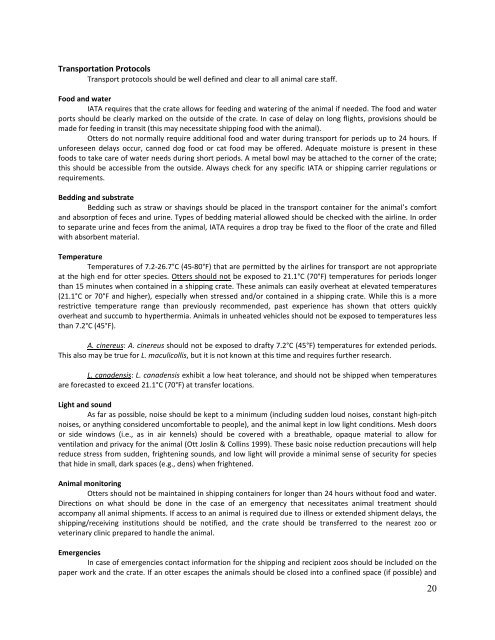Caring for Selected Otter Species (Asian small-clawed, Cape ...
Caring for Selected Otter Species (Asian small-clawed, Cape ...
Caring for Selected Otter Species (Asian small-clawed, Cape ...
You also want an ePaper? Increase the reach of your titles
YUMPU automatically turns print PDFs into web optimized ePapers that Google loves.
Transportation Protocols<br />
Transport protocols should be well defined and clear to all animal care staff.<br />
Food and water<br />
IATA requires that the crate allows <strong>for</strong> feeding and watering of the animal if needed. The food and water<br />
ports should be clearly marked on the outside of the crate. In case of delay on long flights, provisions should be<br />
made <strong>for</strong> feeding in transit (this may necessitate shipping food with the animal).<br />
<strong>Otter</strong>s do not normally require additional food and water during transport <strong>for</strong> periods up to 24 hours. If<br />
un<strong>for</strong>eseen delays occur, canned dog food or cat food may be offered. Adequate moisture is present in these<br />
foods to take care of water needs during short periods. A metal bowl may be attached to the corner of the crate;<br />
this should be accessible from the outside. Always check <strong>for</strong> any specific IATA or shipping carrier regulations or<br />
requirements.<br />
Bedding and substrate<br />
Bedding such as straw or shavings should be placed in the transport container <strong>for</strong> the animal’s com<strong>for</strong>t<br />
and absorption of feces and urine. Types of bedding material allowed should be checked with the airline. In order<br />
to separate urine and feces from the animal, IATA requires a drop tray be fixed to the floor of the crate and filled<br />
with absorbent material.<br />
Temperature<br />
Temperatures of 7.2-26.7°C (45-80°F) that are permitted by the airlines <strong>for</strong> transport are not appropriate<br />
at the high end <strong>for</strong> otter species. <strong>Otter</strong>s should not be exposed to 21.1°C (70°F) temperatures <strong>for</strong> periods longer<br />
than 15 minutes when contained in a shipping crate. These animals can easily overheat at elevated temperatures<br />
(21.1°C or 70°F and higher), especially when stressed and/or contained in a shipping crate. While this is a more<br />
restrictive temperature range than previously recommended, past experience has shown that otters quickly<br />
overheat and succumb to hyperthermia. Animals in unheated vehicles should not be exposed to temperatures less<br />
than 7.2°C (45°F).<br />
A. cinereus: A. cinereus should not be exposed to drafty 7.2°C (45°F) temperatures <strong>for</strong> extended periods.<br />
This also may be true <strong>for</strong> L. maculicollis, but it is not known at this time and requires further research.<br />
L. canadensis: L. canadensis exhibit a low heat tolerance, and should not be shipped when temperatures<br />
are <strong>for</strong>ecasted to exceed 21.1°C (70°F) at transfer locations.<br />
Light and sound<br />
As far as possible, noise should be kept to a minimum (including sudden loud noises, constant high-pitch<br />
noises, or anything considered uncom<strong>for</strong>table to people), and the animal kept in low light conditions. Mesh doors<br />
or side windows (i.e., as in air kennels) should be covered with a breathable, opaque material to allow <strong>for</strong><br />
ventilation and privacy <strong>for</strong> the animal (Ott Joslin & Collins 1999). These basic noise reduction precautions will help<br />
reduce stress from sudden, frightening sounds, and low light will provide a minimal sense of security <strong>for</strong> species<br />
that hide in <strong>small</strong>, dark spaces (e.g., dens) when frightened.<br />
Animal monitoring<br />
<strong>Otter</strong>s should not be maintained in shipping containers <strong>for</strong> longer than 24 hours without food and water.<br />
Directions on what should be done in the case of an emergency that necessitates animal treatment should<br />
accompany all animal shipments. If access to an animal is required due to illness or extended shipment delays, the<br />
shipping/receiving institutions should be notified, and the crate should be transferred to the nearest zoo or<br />
veterinary clinic prepared to handle the animal.<br />
Emergencies<br />
In case of emergencies contact in<strong>for</strong>mation <strong>for</strong> the shipping and recipient zoos should be included on the<br />
paper work and the crate. If an otter escapes the animals should be closed into a confined space (if possible) and<br />
20
















